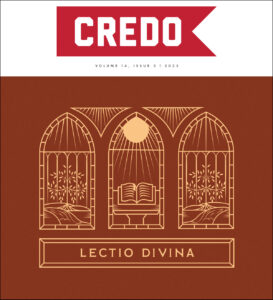Most of my work is centered around college students. I have worked directly with 18-22 year olds for the past thirteen years. There has been notable differences as the generation has shifted from the youngest Millennials to the oldest of Generation Z. Yet, one thing that has remained constant is their inexperience of how to regularly engage the Word of God in their daily life. In my particular circle the issues centers around an illiteracy of the Word, an ignorance on what to do with the Bible once they have it in front of them, and the problem of time. The practice of slowing down is making a resurgence among modern protestants through the work of pastors like John Mark Comer.[1] Most students, however, check their schedules and see very little space for practices that will produce holiness. If anything, they find a few minutes to open the Bible, find a few verses or follow their reading plan, quickly read, maybe write a few words of devotional content, pray quickly and earnestly for God to multiply their words and his favor, and then run to their next class. Unfortunately, the students whose field will soon be the ministry of the church are running at the same pace and reading in the same way.
Some problems need new solutions; others need practices that have stood the test of time and are almost as ancient as the text being read. Click To Tweet I have come to realize the problems listed above are not sequestered to a particular age group but are evident in most churches and across all age groups. The question then becomes how does a pastor shepherd his congregation to regularly engage the Holy Word slowly, deeply, and prayerfully? Some problems need new solutions; others need practices that have stood the test of time and are almost as ancient as the text being read. Eugene Peterson cites that the practice of Lectio Divina originates in the twelfth century with Guigo the Second, an Italian monk.[2] Evan Howard finds reference to the art of spiritual reading as far back as St. Benedict of the sixth century.[3] Either way, the discipline of Lectio Divina, the intentional practice of reading, meditating on, praying over, and contemplating the Scriptures is valid for the Church today. Peterson is helpful in distinguishing the difference between a “normal” or academic reading of the text and the reading of the Lectio. He states, “In spiritual reading we do not take control of the text, we let the text take control of us.”[4] Similarly, Howard believes the end goal of this type of reading is spiritual growth and the hope to bear fruit in the Christian.[5] By the sounds of it this reading of the text may be quite different than a cursory glance over a few verses and a short prayer.
The question then becomes: How does the pastor as shepherd guide his congregation through deeply experiencing the Word of God as a transformative collection of books that has the power not only to save the lost but also sustain the follower of Christ? I think this occurs in two movements. First, the pastor must practice before he preaches. Second, the pastor as shepherd educates, guides, and experiences the Lectio with his people.
Personal Before Public.
Leading people to engage disciplines should not begin until the pastor understands, agrees with, and has practiced the discipline himself. How can you teach on fasting if you have never felt the pain of hunger and been led to the Word of God to be spiritually filled instead of turning back to the temporary filling of food? How can you advise others to pray if you have not experienced the work of God in your own heart as you slowly but surely learn to pray as Christ modeled? The transfer of information will not aid in transformation like the transfer of experience. The transfer of information will not aid in transformation like the transfer of experience. Click To Tweet
Just as any preacher delivers his sermon throughout the week first to his own soul each day before he actually speaks into a public space; so should the practice of Lectio Divina occur. The personal formation through the use of this spiritual reading is paramount. The daily routine of reading, meditating, praying, and contemplating must be a rhythm before it becomes a recommendation. This is not to mandate that this practice cannot be suggested as you increase your own personal experience and practice of it. It is beneficial, however, to understand the exercise, the comforts and discomforts it may bring, and then move toward shepherding the church to be formed in this way.
Public – Back to Your People.
Once the pastor has personally engaged the practice, understanding it, wrestling with it, letting it expose his deepest inadequacies to be supplied strength from the Spirit, then should he present it to his congregation to guide them in this ancient practice that engages both the mind and the heart. This can be accomplished in multiple formats. Here I look to the Puritans for guidance. Charles Hambrick-Stowe in his important work on Puritan devotional exercise, The Practice of Piety, provides a clear devotional matrix understood by the Puritan pastor. All exercises of spiritual formation were funneled from public worship, to private exercises, concluding with secret practices. This method ensured that spiritual formation was occurring at various levels from the Sabbath day to the seventh day.
Public Worship. The sacred space where Christians gather each Sabbath is holy and should be used accordingly. What better place than the corporate gathering of the people of God to educate and practice the discipline of Lectio. After all, this is not really an introduction to a completely new discipline as you certainly read Scripture and pray each time you gather. One way to use this spiritual reading publicly is to educate your people: You could preach on the importance of reading the Scripture, meditating on it, praying over it and with it, and then continuing to think on it and apply it (contemplation) as they move forward. You could preach a series where each sermon covers one of the elements of the discipline. My suggestion: Walk through the stages of Lectio during a service. First, as you have the text read aloud you could pause and allow people time to chew and digest the Word of God. Or you could allow your people time to reflect after you have expounded the text. Next, you could lead them through prayer with prompts or questions to further their understanding. Finally, you can exhort them as they leave to apply to their day what God has revealed to them with a sense of wonder and awe at the goodness of God. This is not the mere transfer of information but the transfer of an experience.
Private Exercises. When we consider the private exercises, we are dealing with the regular, weekly gathering of the church outside of the Sabbath service. Think of this as the time your church gathers in small groups all around your city in restaurants, parks, or homes. In addition to the experience you provide publicly you can aid in a private experience with curriculum to learn about the practice of spiritual reading; follow up questions so people can debrief their experience if you actively participated in it publicly; or invite each group to participate anew together by engaging each step of the Lectio together.
Secret Practices. As you continue to personally practice the Lectio, shepherd your church in their practice of it, and encourage each parishioner to endeavor to spiritually read the Bible. They may find this new rhythm transforms their soul. To be clear, I am not antagonistic toward the modern devotional method. However, the standard “quiet time” that involves a direct reading, a move toward journaling, and a short prayer may need a breath of fresh air. It is worth chewing on the Scripture, praying back the Word to God, and thinking of it throughout the day in application.
Lectio Divina may conjure up mystical notions and yet, most often, I find that its mysticism is connected more to misunderstanding. For traditionally, the mystics focused on great union with Christ, as does Lectio, however, the mystics had the propensity to set aside the Holy Writ and elevate experience. What is mysterious about the Lectio is the Spirit’s ability to use the Word of God and transform His people. The art of teaching spiritual formation is as complicated as it is wonderful. Thankfully, spiritual formation in the church is a lifelong journey for each individual and for the life of the church. Pastor, do not lose hope that your people do not today know how to seek deep union with Christ. Begin again, begin with yourself, and model for them how to seek Christ – slowly, deeply, prayerfully, living differently because the Spirit will speak through the Word we hold to so dearly.
Endnotes
[1] John Mark Comer, The Ruthless Elimination of Hurry: How to Stay Emotionally Healthy and Spiritually Alive in the Chaos of the Modern World (Colorado Springs: Water Brook, 2019).
[2] Eugene Peterson, “Spiritual Reading (Lectio Divina),” in Dictionary of Christian Spirituality, edited by Glen G. Scorgie (Grand Rapids: Zondervan, 2011), 768.
[3] Evan Howard, “Lectio Divina in the Evangelical Tradition,” in Journal of Spiritual Formation and Soul Care 5 (2012), 58.
[4] Peterson, 768.
[5] Howard, 58.


